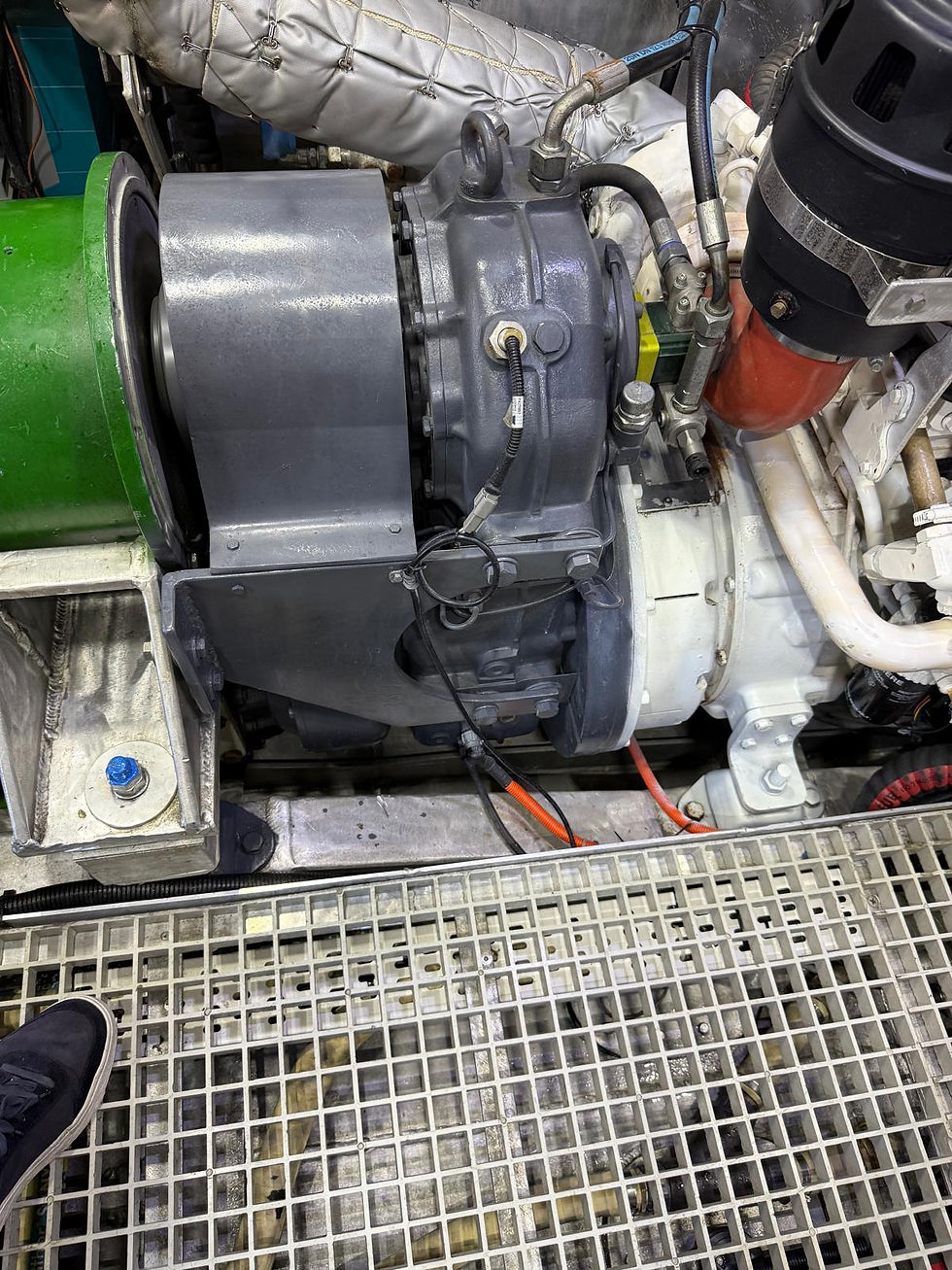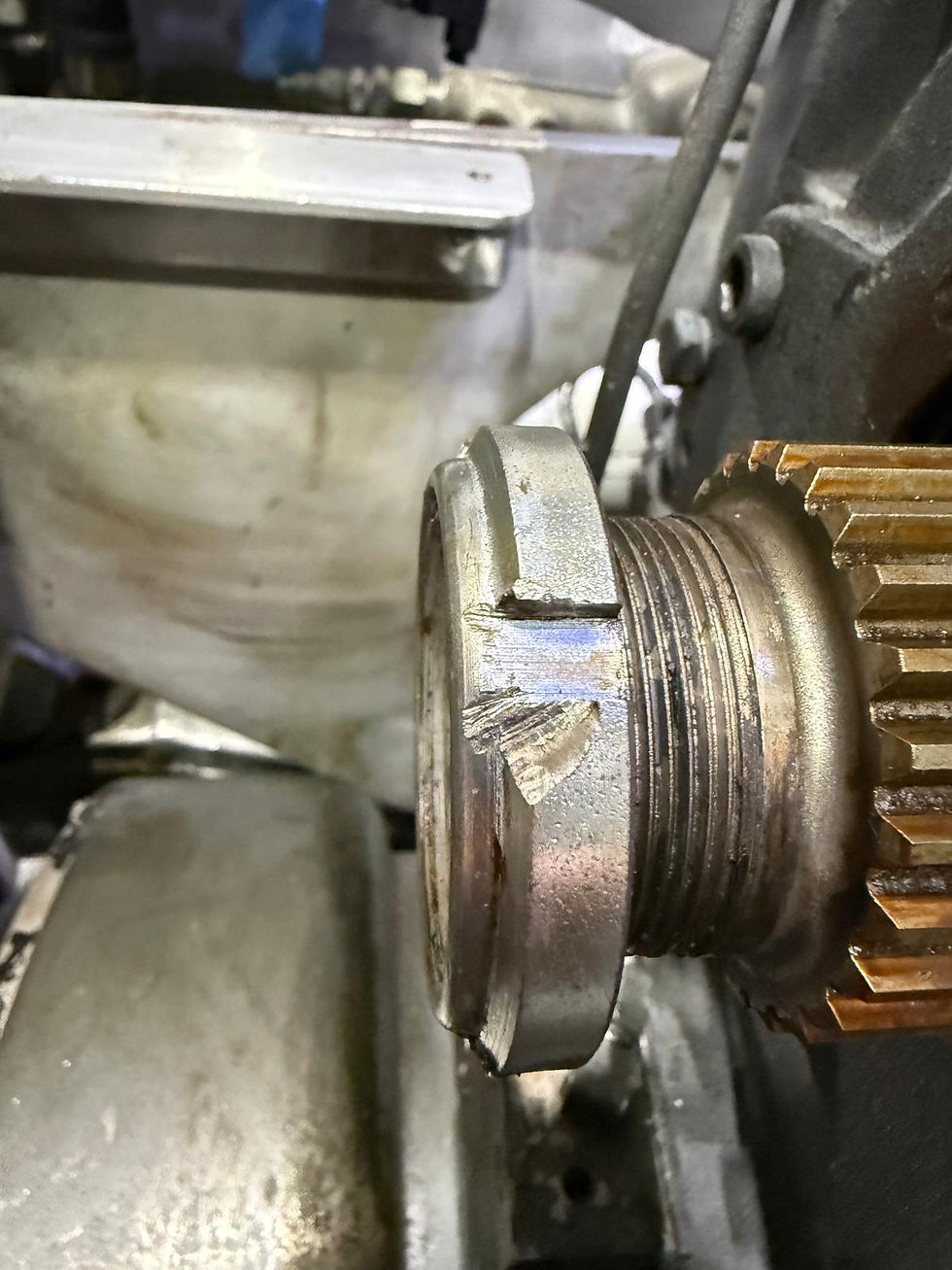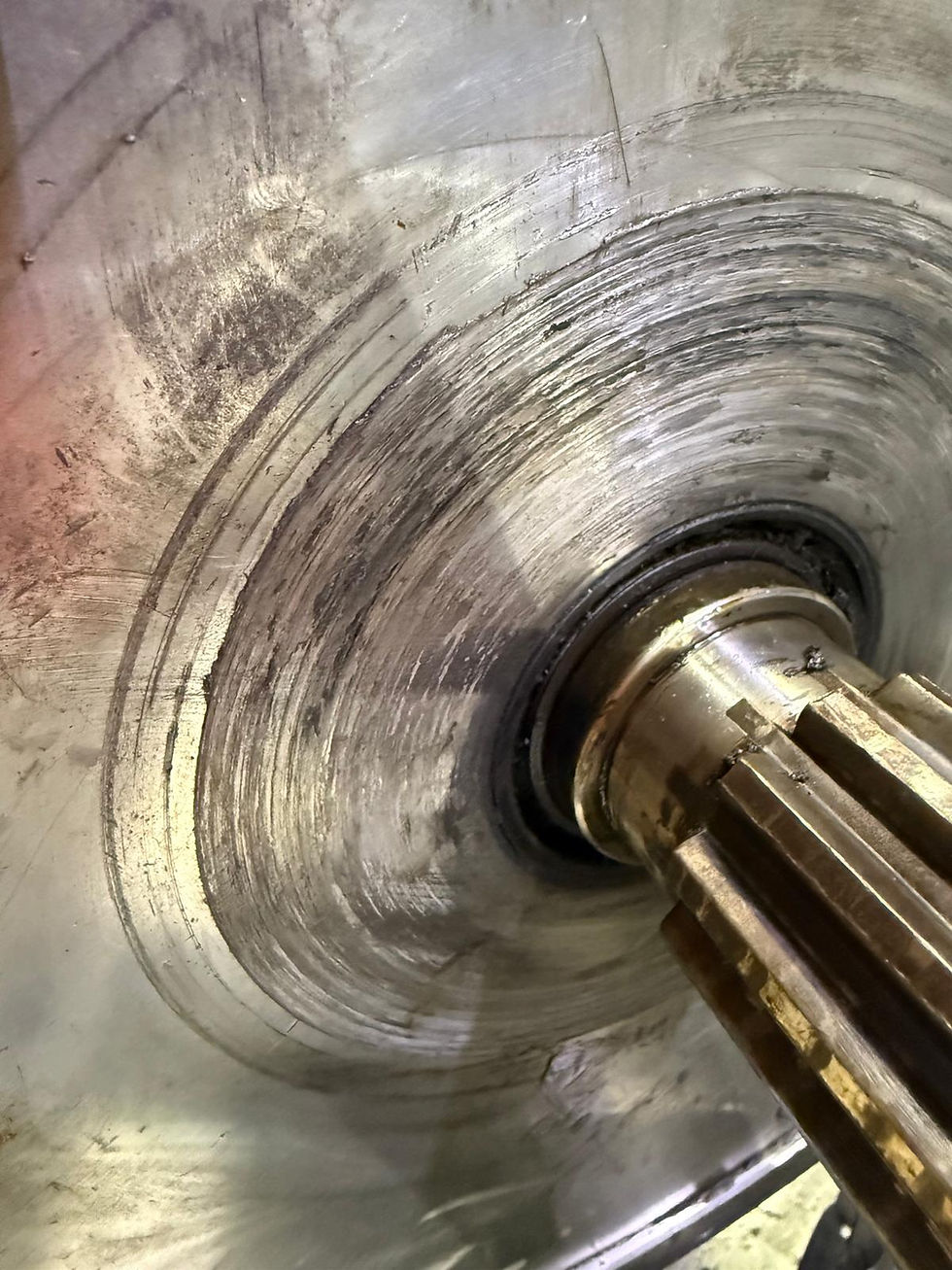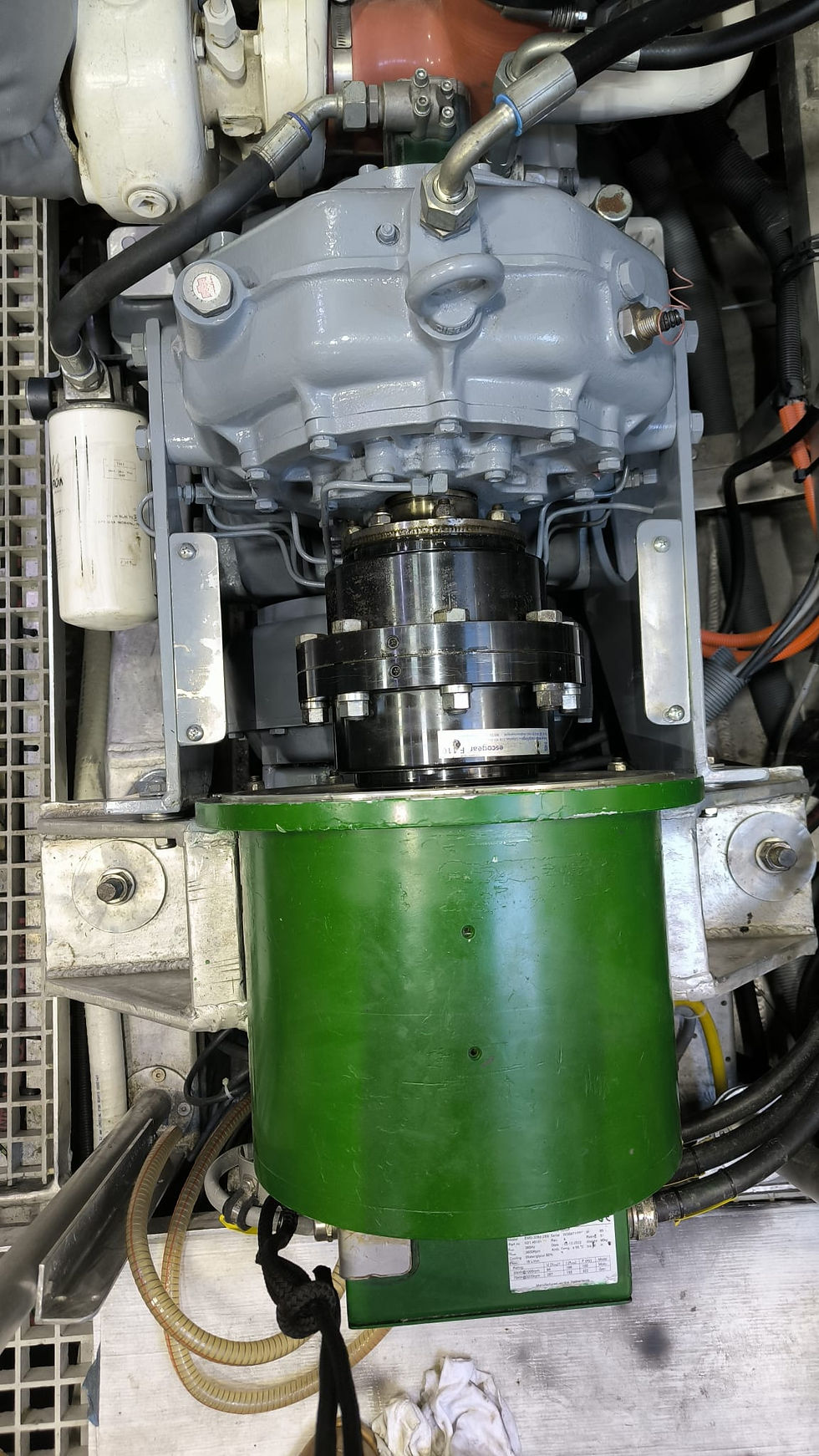Last week, we spoke about "less is more" in that particular example, removing an overabundance of shims used to align the drivelines on Vanguard. The nature of such work demands close attention, which can often reveal the onset of other, more subtle problems. So here is that story:

Our hybrid E-Motor drives consist of three hefty assets: a 30kW E-Motor from Praxis Automation that doubles as a motor and generator, a coupling, and, thirdly, a step-up gearbox (PHT) from Esco Power. After fixing a few initial hiccups, these robust components performed well, and charging at 30kW is a blessing in quiet anchorages. Vanguard's design boasts impressive redundancy for its mission, which can create a false sense of security— a repeated mistake adds no security.
While realigning the drives, we discovered a surprising backlash in the port engine Hybrid drive coupling. Since the drive is bidirectional, we shouldn't have seen any backlash. With a stroke of luck, we had time for a strip-down, which led us to share our findings with Naval Yachts and Esco Power. Esco Power responded promptly and worked with us to find a solution. Naval Yachts installed the unit; however, they immediately opted for the blame game, which was unsurprising, given previous experiences. Hope springs eternal, or so they say! (We subsequently stripped the Stbd drive to find similar but less extensive damage attributable to the same reasons.)
So, what went wrong? Well, three issues stood out:


1. Construction supervision.
Naval Yachts (or their subcontractor) used a cold chisel instead of the specified tool to tighten a retaining lock ring. As a result, it wasn't fully locked in, allowing axial movement and leading to some lovely metal-on-metal fretting at the drive end.
2. Machining mishaps.
The splined connection to the E-Motor was noisy and didn't meet the specified standards per drawing DIN 8420. It was tight initially, but everything loosened up when under load, which is always a great way to keep things interesting.
3. A classic case of 'close enough.'
A design flaw meant that the E-Motor end of the coupling could move forward but not back, relying on the E-Motor casing to keep it in check. That genius design idea resulted in scoring, heat buildup, and a nice little vibration show.
Most problems have multiple solutions, so work with what you have. We first consulted Esco Power about the issues, and their technical support agreed with our assessment. We also spoke to the shipyard in Fort Lauderdale, Yacht Management of South Florida, for local machine shops, ultimately landing on Tropic Machine and Fabrication. We kept Naval Yachts in the loop, but they immediately played their predictable blame card—a lesson slow learned.
Implementing a repair.
Starting at the PHT drive, the output is taken by a connecting flange driven via a splined output shaft. The backlash was minimal (Esco Power had machined both components). We added molybdenum disulfide anti-fretting paste to the splines before reassembly. Additionally, we procured new Nylock retaining nuts and torqued them to specification with the help of a newly made dedicated assembly tool.
Top Row - Naval Yachts assembly using a cold chisel on the nyloc nut, damage to nut, red coloration on splines from fretting damage.
Bottom Row - new nut and purpose-made assembly tool. Clean tight assembly with no backlash.
Welding the hefty shaft retaining washer to the splined E-Motor coupling will prevent axial movement of this component. Previously, all damaged surfaces had been dressed and trued to the axial dimension. The coupling was reassembled onto the E-Motor shaft using Loctite 660. This was not a preferred choice but was necessitated by the level of wear on the splines. An alternative was to re-machine those splines, entailing approximately a 4-6 weeks delay. We used a small washer to ensure clearance from the motor casing, then torqued the M10, Class 12.9 Allen screw to 95NM before letting the Loctite set up overnight.
E-Motor end coupling, before Top, after Bottom. We had about 0.3mm play and used Loctite 660 as a semi-permanent securing compound to prevent backlash and ongoing fretting.

Loctite 660 is designed to retain worn splines and keyways on shaft lines. It is a permanent solution but can be removed by heating to>240 deg.C. Once set up, a we confirmed concentricity before the Loctite could cure fully. The e-Motor was replaced. Next we realigned the E Motor to the PHT drive, this necessitated lifting the E-motor support cradle to remove shims as the alignment has initially be set wrongly, (no surprise there).
We will test the completed assemblies next week when the exhaust modifications are also completed. If this does not work as intended, Plan B is to replace the coupler assembly with a flanged rubber industrial motor drive coupler. 30kW at between 1000 and 3200 RPM is quite a low torque requirement, so it should be an easy swap out that we can complete in Charleston, SC.
A shout-out here for the engineering assistance provided by Zach, Ceaser, and the team at Tropic Machine and Fabrication. 72 hour turnaround!
web site: www.tropicmachine.com
Now, does Naval Yachts (Antalya) stand behind their work after only 300 hours of operation?
I typically avoid negative comments, preferring to focus on outcomes and the journey. However, one observation about Naval Yachts is well overdue. Dincer Dinc, Technical Director and co-owner is steering this process. Over eleven months since the chaotic delivery of an incomplete build and through a detailed rebuild at our own expense, we come to realize that Naval Yachts "Guarantee Policy" is a marketing stunt; it will not be honored and has zero value.
On a brighter note, Vanguard has now been approved independently by UK MCA as seaworthy - Category (2) at our own effort and expense, despite this behavior from Naval Yachts.
When the remaining repairs are completed, we will ride the Gulf Stream north to Charleston (against a northerly wind, if there is one, letting the seas stack up). That should be a worthy test of the upgrades. Caveat Emptor, folks!
Lastly, this morning I woke up early, 5.30 am as usual; this was the view that greeted me from my cabin. You have to love Fort Lauderdale.




























